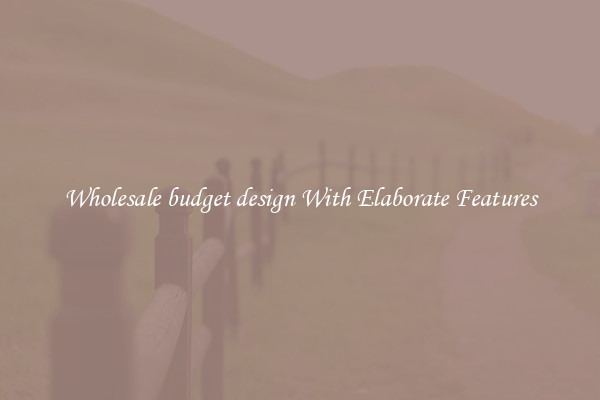Wholesale budget design With Elaborate Features
Wholesale Budget Design with Elaborate Features

When it comes to designing a wholesale budget, there are several key features that should be considered to create an effective and efficient system. These features help streamline the budgeting process and ensure that all necessary elements are incorporated to achieve financial goals. Let's explore some of these elaborate features.
1. Comprehensive Cost Analysis: The first step in designing a wholesale budget is a thorough analysis of all costs involved. This includes assessing fixed costs such as rent, utilities, and overhead expenses, as well as variable costs like inventory, employee wages, and marketing expenses. A comprehensive cost analysis helps identify areas where expenses can be minimized or optimized.
2. Sales Forecasting: Accurate sales forecasting is crucial for wholesale businesses. This feature involves analyzing historical sales data, market trends, and customer behavior to predict future sales. By accurately projecting sales, businesses can adjust their budgets accordingly, allocate resources effectively, and avoid overspending or understocking.
3. Inventory Management: Maintaining optimal inventory levels is essential for wholesalers. An elaborate budget design should include features that track inventory levels, monitor product movement, and determine reorder points. Effective inventory management helps minimize carrying costs, prevent out-of-stock situations, and improve customer satisfaction.
4. Profit Margin Analysis: Profit margin analysis allows wholesalers to determine the profitability of each product or service they offer. By analyzing profit margins, businesses can identify high-profit items and make informed decisions about pricing, discounts, or discontinuing low-margin products. This analysis also helps identify opportunities for cost reduction and revenue maximization.
5. Variance Analysis: Variance analysis is the comparison of actual financial results with the budgeted amounts. This feature helps identify discrepancies and pinpoint areas where the budget may need adjustment. For example, if expenses are consistently higher than budgeted, it may indicate the need to cut costs or reallocate resources. Variance analysis also provides insights into the effectiveness of budgeting and helps improve future forecast accuracy.
6. Goal Setting and Tracking: Wholesale budget design should include the ability to set clear financial goals and track progress towards achieving them. By setting measurable objectives, businesses can monitor their performance, identify areas of improvement, and take corrective measures if necessary. This feature helps create accountability and motivates teams to strive for financial success.
7. Reporting and Analysis: Effective wholesale budget design requires robust reporting and analysis capabilities. The system should generate regular financial reports that provide managers with insights into profitability, cash flow, expenses, and other key performance indicators. The ability to generate customizable reports aids decision-making, facilitates financial planning, and supports effective resource allocation.
In conclusion, designing a wholesale budget with elaborate features is vital to the success of any wholesale business. By incorporating comprehensive cost analysis, sales forecasting, inventory management, profit margin analysis, variance analysis, goal setting and tracking, and reporting and analysis, businesses can enhance their financial planning and achieve their financial objectives. With these features in place, wholesalers can streamline their budgeting process, maximize profitability, and make informed decisions for sustainable growth.

View details

View details

View details

View details








